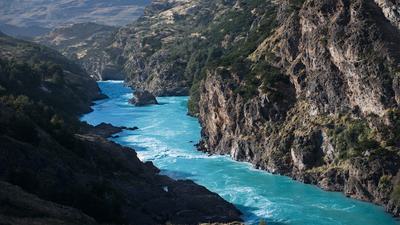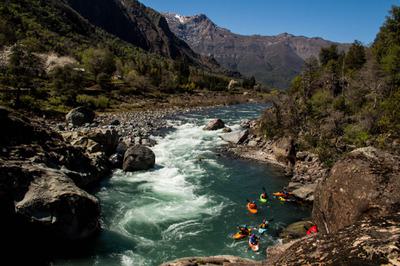In Chile and other places, we have come to this point because the traditional Western view of rivers has failed us.
With the number of dams in Chile at 137 and counting, indigenous people, citizens, and environmental activists [including the authors, members of the Chilean Free-Flowing Rivers Network] say the time has come to look at granting legal rights — a form of legal personhood — to the nation’s rivers. This campaign is not occurring in isolation, however, and is taking inspiration from other countries where a small but growing number of courts and legislatures have begun bestowing legal rights upon rivers. Three countries — New Zealand, Colombia, and India — have all taken such steps over the past two years, though the practical ramifications of these declarations remain unclear.
In Chile, as in other places, we have come to this point because the traditional Western view of rivers — and of nature generally — has failed us. Western legal systems and governments traditionally viewed water and water rights as property, leading to overuse and contamination. One criticism levied by environmental groups is that in countries like Chile and the United States, corporations are granted the same rights as people while the living ecosystems upon which we depend for survival are not. Chile’s Water Code was established during the Pinochet dictatorship, and still treats water as a replenishable (rather than increasingly scarce) natural resource. Under the code, companies may trade water rights to the highest bidder. Water is not a universal right in Chile, but a corporate one. This has inevitably led to the degradation of many rivers and the ecosystems they support, as well as to ongoing conflicts among users.
In figuring out how countries can reverse this environmental degradation and reduce conflicts, a lot can be learned from the indigenous view of rivers. Legal innovations that successfully incorporate this outlook could better protect rivers, essentially by giving them the same basic rights as people.
A Chilean energy company is seeking permits to restart the building of an unfinished dam along the San Pedro River. Carlos Lastra
Today, the Mapuche nation — which retained autonomy until the 1880s, when it was finally occupied by the newly independent Chilean Republic — numbers around 1.1 million strong. Their territory extends across the southern portions of present-day Chile and Argentina. It’s easy for an outsider to understand why the Mapuche fought so hard for their homeland; the region is defined by lush forests, spectacular landscapes, and some of the most stunning rivers on the planet, including, until its recent damming, the Biobío. Robert F. Kennedy Jr., a founder and senior attorney with the global Waterkeeper Alliance, said the Biobío was once “the jewel of Chile” and compared it to the Grand Canyon.
The cultural importance of the Biobío is heavily reflected in the Mapuche worldview, which presents a duality of one great earthly river and one spiritual river coexisting to create a balance between the earthly and spiritual dimensions. The Biobío signifies the terrestrial river, its hundreds of branches extending throughout the region, around which innumerable families constituted their lineages. Above the Biobío flows the great river of the sky, the Wenu-leufú, what Western astrologers labeled the Milky Way. This “galactic river” is home to the ancestors who inhabited the earth since its origins.
As this duality indicates, Mapuche culture is built around a profound understanding of and interdependence with rivers. Like the Eskimo-Aleuts and their more than 50 words for snow, the Mapundungun language has numerous words for water — trayenko, lil, menoko, leufú, leufquén, traytrayko, to name a few. Mapuche view rivers, lakes, and wetlands as sacred places inhabited by a great diversity of not just flora and fauna, but also spirits, which the Mapuche call ngen. If you want to enter the home of a ngen in search of medicine, food, or water, you must first ask permission.
Each river nook and eddy has its own ngen, meaning a single watershed and its people can be protected by hundreds of spirits. Contaminate or dam a river, even a small tributary, and the ngen will leave, abandoning the place and its people. Since ngen are protectors of both the land and its people — Mapuche literally means “people of the land” — their departure leaves the people who remain to suffer. In Western terms, suffering comes in the form of depression, alcoholism, and other mental and social health issues that have been widely documented in Mapuche communities that inhabit the upper, dammed part of the Biobío’s watershed. Thus, for the Mapuche and other indigenous communities, conservation of the natural environment is also a matter of public health.
In 2017, New Zealand granted the status of legal personhood to the Whanganui River, the third-longest in the country.
A key question now faces communities like the Mapuche and others around the world: Given the likelihood of ongoing water conflicts and continuing degradation of rivers, what legal changes could help protect both rivers and communities?
One solution to reducing conflicts draws on the “corporations are people” logic, applying it to waterways. Over the last two years, a series of legislative acts and court decisions have emerged across the globe that propose caring for a river as if it were a person. In 2017, New Zealand granted the status of legal personhood to the Whanganui River, the third-longest in the country and, the indigenous Māori believe, a living ancestor of their people. In doing so, the New Zealand parliament merged Western legal values with the Māori worldview to resolve the country’s longest-running water conflict, during which the Māori fought hydroelectric projects and gravel extraction schemes.
Under the new agreement, the Whanganui has the same rights as a person. A special committee that includes community representatives is authorized to act as legal administrator, and the river can now be represented in court proceedings. The river will be represented by two officials, one from the Whanganui iwi (Māori word meaning “people”) and the other from the government. Through the agreement, the Whanganui iwi will be granted authority to conduct cultural activities, give official geographic name assignments, and get financing for social and environmental projects, which include the river’s ecosystem restoration.
A proposed dam on Chile's Ñuble River is expected to flood 4,200 acres in the middle of a World Biosphere Reserve. Paulo Urrutia
In May 2017, Colombia’s Constitutional Court granted legal personhood to the Río Atrato, part of the Chocó biogeographic region, an important biodiversity hotspot. The Atrato flows through the territories of 91 different indigenous communities for whom the river is the main source of both food and cultural traditions. The court’s decision establishes the Atrato River as a “subject of rights, which entails its protection, conservation, maintenance, and, in the specific case, restoration.” The decision instructs the government to create an Atrato Guardians Commission consisting of 14 legal guardians from communities affected by mining and pollution.
The river is the first in Colombia to receive this status, the result of local environmental campaigns against the mining industry. Gold mining was the first activity on the Atrato to draw international attention, and has badly damaged sections of the river through the use of dredging machines and mercury and cyanide used in the gold mining process. Recognition of legal personhood for the Atrato seeks to stop or lessen the damage caused by mining and clean up the mess made to date. However, local groups are still struggling to find a practical way to implement these legal protections.
Another notable decision regarding the legal personhood of rivers was handed down by India’s High Court of Uttarakhand in 2017. This ruling declared both the Ganges and Yamuna rivers living entities with legal rights. The decision was short-lived, however, since India’s Supreme Court overruled it out of concern for practical application of the ruling. In 2017, the Madhya Pradesh state legislature also passed legislation recognizing the Narmada River as a living entity, citing both religious reasons and the river’s importance for drinking water and agriculture.
Despite the promise held by establishing legal rights for rivers, difficult questions remain.
Those declarations are an important first step, but given the high levels of contamination in Indian waterways, it remains unclear how far these legal actions will go in remediating the problems. The Ganges is a profoundly contaminated river, with high levels of heavy metals other toxins caused by human activities. When and if India’s government or its courts bestow legal status on the Ganges and other waterways, officials must not only curtail ongoing pollution but also launch restoration programs to return these sick rivers to health.
Despite the promise held by establishing legal rights for rivers, difficult questions remain. What does it mean for a river to have the rights of a person? Does a river have the right to flow freely, and does this mean its waters can’t be dammed or diverted? Is compensation to affected communities permissible in lieu of court orders requiring removal of large obstructions like dams? What can we do to move beyond merely acknowledging humanity’s connection to rivers to actually saving them? And, finally, and perhaps most important, how should a legal regime determine who will advocate on behalf of a river, which lacks a voice of its own? In the future, these are questions policymakers will have to address.
Camila Badilla, coordinator of the Chilean Free-Flowing Rivers Network, says that granting legal rights to rivers is just one step in an ongoing transformation in how humans view their place in the natural world. “Perhaps in the future we will stop feeling like the center of nature,” she says. “Granting a right to a river is the first big step to opening ourselves up to seeing and understanding other living beings.”
Grant Gutierrez, a U.S. environmental anthropologist at Dartmouth College, and Tomas Gonzalez Astorga, a Chilean kayaker and natural resources engineer who coordinates the commission of investigation of the Chilean Free-Flowing Rivers Network, also contributed to this article.





